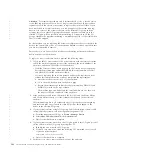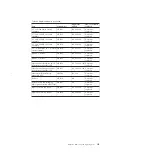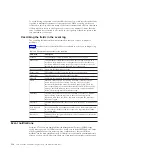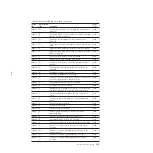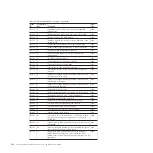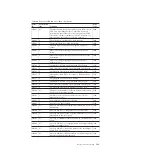
To avoid having a repeated event that fills the event log, some records in the event
log refer to multiple occurrences of the same event. When event log entries are
coalesced in this way, the time stamp of the first occurrence and the last occurrence
of the problem is saved in the log entry. A count of the number of times that the
error condition has occurred is also saved in the log entry. Other data refers to the
last occurrence of the event.
Describing the fields in the event log
The event log includes fields with information that you can use to diagnose
problems.
Table 23 describes some of the fields that are available to assist you in diagnosing
problems.
Table 23. Description of data fields for the event log
Data field
Description
Event ID
This number precisely identifies why the event was logged.
Error code
This number describes the service action that should be followed to
resolve an error condition. Not all events have error codes that are
associated with them. Many event IDs can have the same error code
because the service action is the same for all the events.
Sequence number
A number that identifies the event.
Event count
The number of events coalesced into this event log record.
Object type
The object type to which the event log relates.
Object ID
A number that uniquely identifies the instance of the object.
Fixed
When an alert is shown for an error condition, it indicates if the
reason for the event was resolved. In many cases, the system
automatically marks the events fixed when appropriate. There are
some events that must be manually marked as fixed. If the event is a
message, this field indicates that you have read and performed the
action. The message must be marked as read.
First time
The time when this error event was reported. If events of a similar
type are being coalesced together, so that one event log record
represents more than one event, this field is the time the first error
event was logged.
Last time
The time when the last instance of this error event was recorded in the
log.
Root sequence
number
If set, this number is the sequence number of an event that represents
an error that probably caused this event to be reported. Resolve the
root event first.
Sense data
Additional data that gives the details of the condition that caused the
event to be logged.
Event notifications
Storwize V7000 can use Simple Network Management Protocol (SNMP) traps,
syslog messages, and Call Home email to notify you and the IBM Support Center
when significant events are detected. Any combination of these notification
methods can be used simultaneously. Notifications are normally sent immediately
after an event is raised. However, there are some events that might occur because
114
Storwize V7000: Troubleshooting, Recovery, and Maintenance Guide
Содержание Storwize V7000
Страница 1: ...IBM Storwize V7000 Version 6 3 0 Troubleshooting Recovery and Maintenance Guide GC27 2291 02...
Страница 6: ...vi Storwize V7000 Troubleshooting Recovery and Maintenance Guide...
Страница 8: ...viii Storwize V7000 Troubleshooting Recovery and Maintenance Guide...
Страница 10: ...x Storwize V7000 Troubleshooting Recovery and Maintenance Guide...
Страница 34: ...18 Storwize V7000 Troubleshooting Recovery and Maintenance Guide...
Страница 42: ...26 Storwize V7000 Troubleshooting Recovery and Maintenance Guide...
Страница 80: ...64 Storwize V7000 Troubleshooting Recovery and Maintenance Guide...
Страница 128: ...112 Storwize V7000 Troubleshooting Recovery and Maintenance Guide...
Страница 156: ...140 Storwize V7000 Troubleshooting Recovery and Maintenance Guide...
Страница 166: ...150 Storwize V7000 Troubleshooting Recovery and Maintenance Guide...
Страница 171: ......
Страница 172: ...Printed in USA GC27 2291 02...



